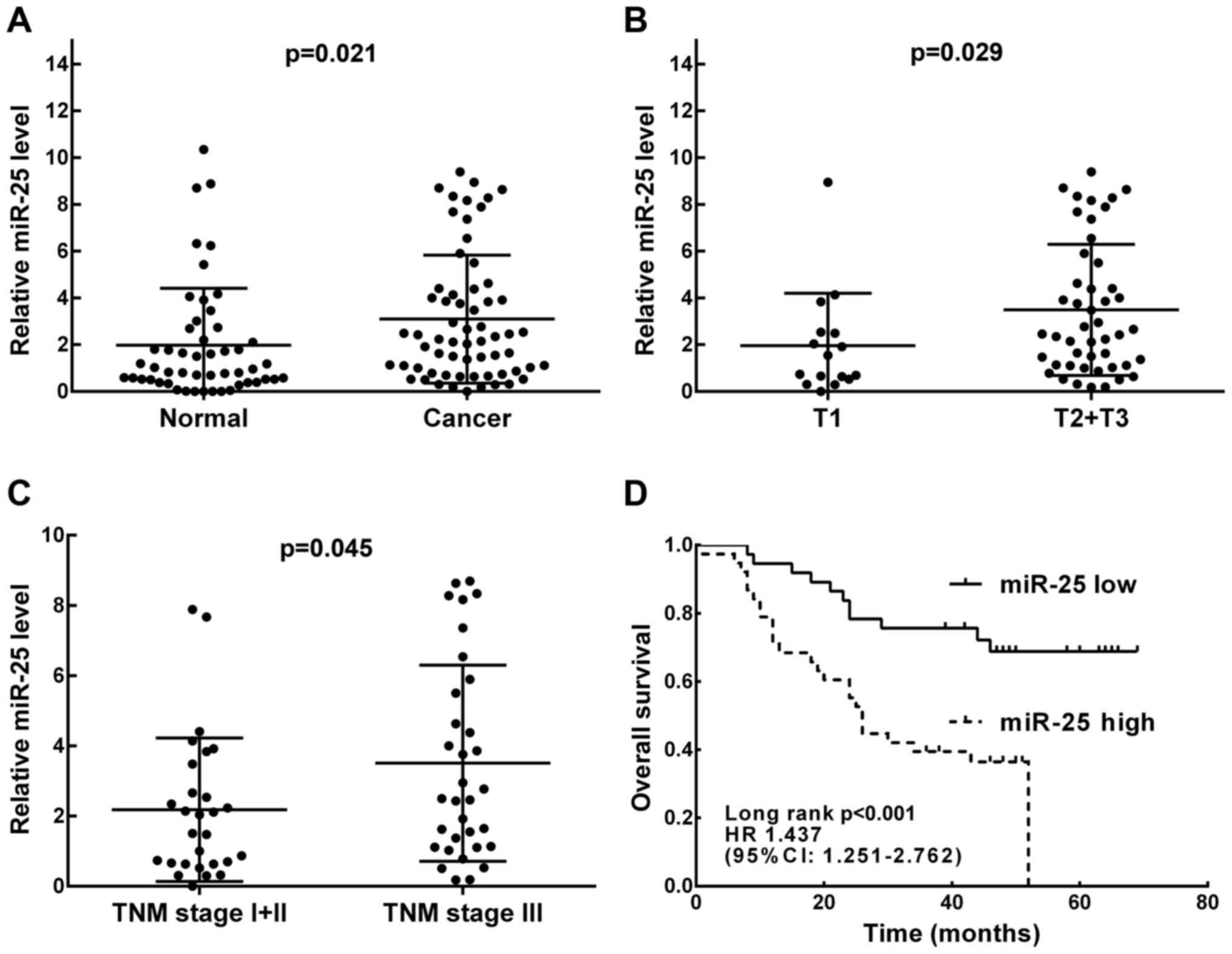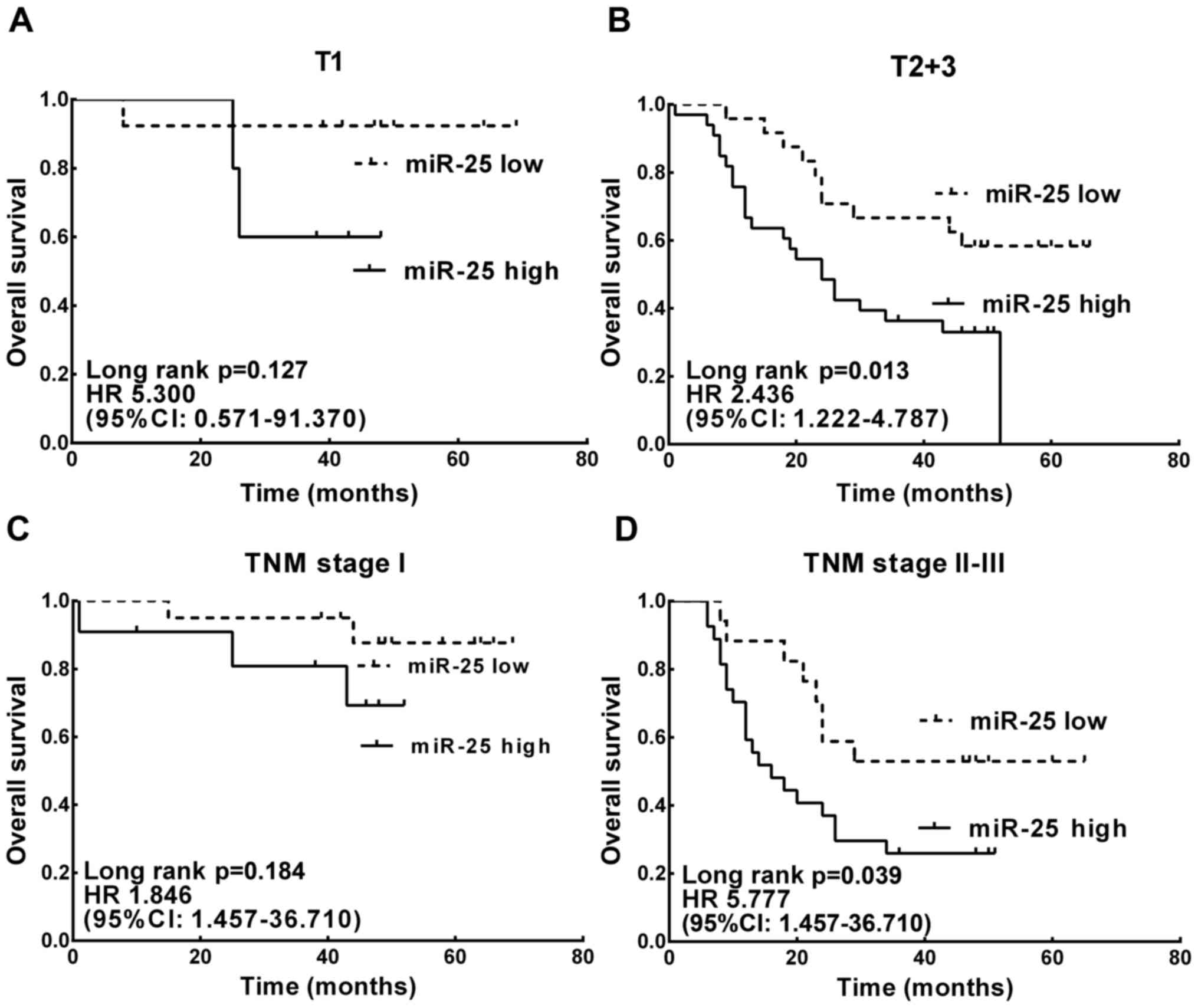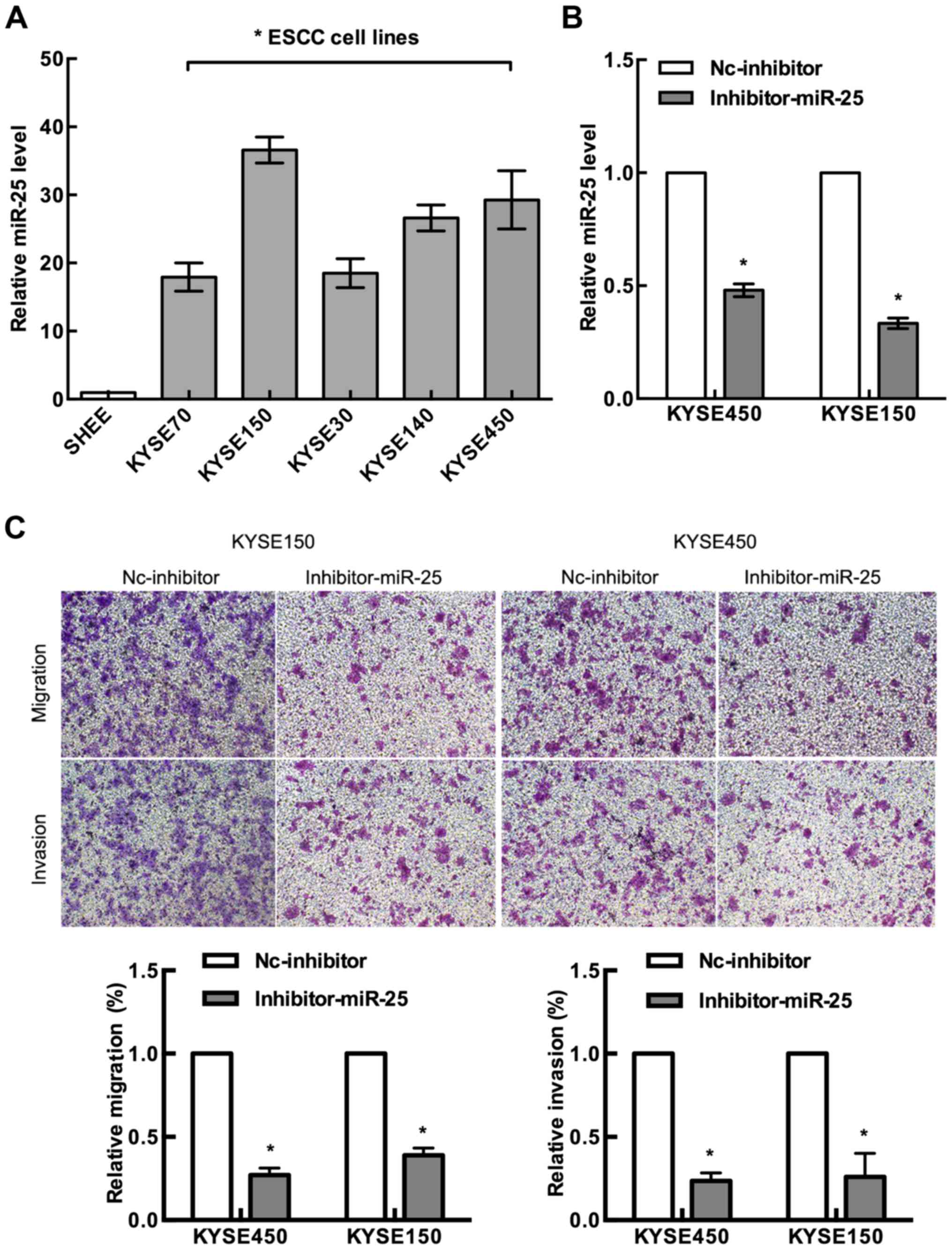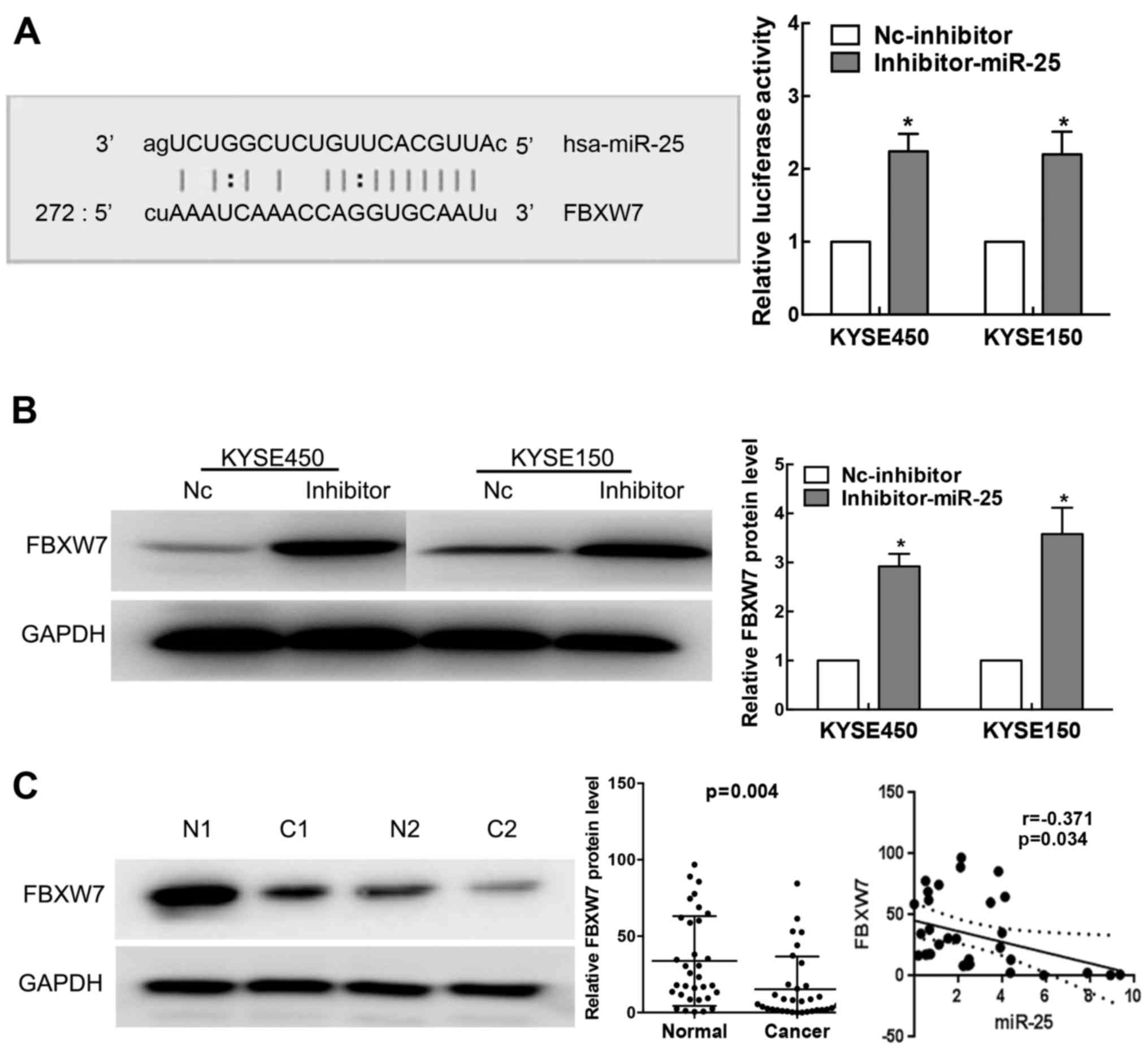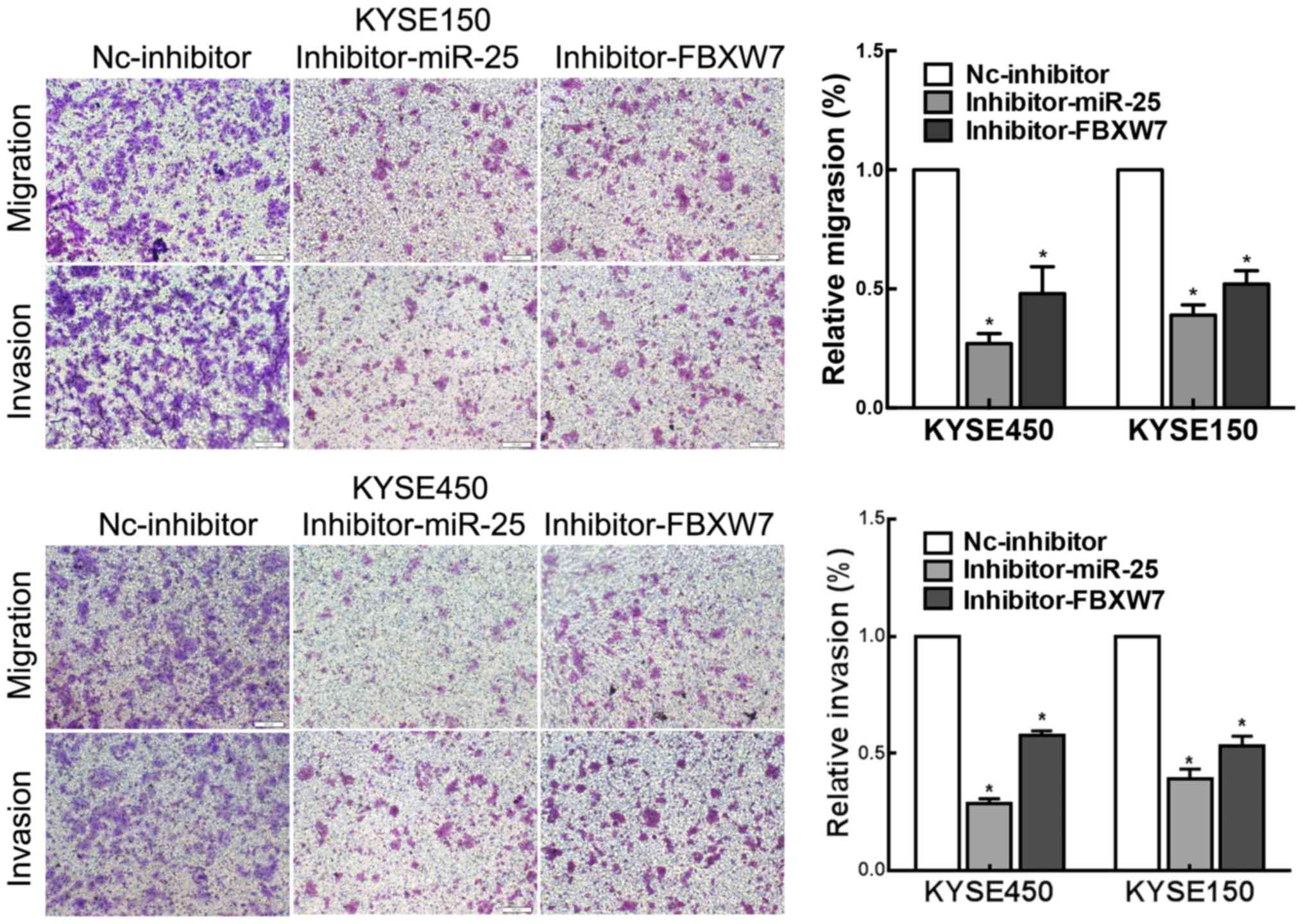miR-25 promotes metastasis via targeting FBXW7 in esophageal squamous cell carcinoma
Retraction in: /10.3892/or.2023.8644
- Authors:
- Published online on: September 25, 2017 https://doi.org/10.3892/or.2017.5995
- Pages: 3030-3038
Abstract
Introduction
Esophageal cancer is a highly lethal malignancy. As the main type of esophageal cancer, esophageal squamous cell carcinoma (ESCC) accounts for ~90% of all esophageal cancer cases (1,2). However, patients with ESCC are usually diagnosed at advanced stages (3). Recently, advances in the application of combined chemotherapy and radiotherapy, alone or as an adjunct regimen to surgery, have improved the prognosis of ESCC patients (4). Cumulative evidence suggests that a number of oncogenic and tumor-suppressive genes are associated with the initiation and progression of ESCC (3). Yet, the molecular mechanisms underlying the deregulation of the cellular phenotype in ESCC have not been fully clarified. Elucidation of the genetic alterations and underlying molecular pathways involved in ESCC may facilitate the identification of novel targets, as well as improve disease diagnosis and therapy.
MicroRNAs (miRNAs), a kind of endogenous RNA gene products consisting of 18–25 nucleotides, have been identified as important regulators of human malignancies (5). Recently, using detection techniques such as RNA sequencing and microarray, there are various findings that have illustrated the expression profile of miRNAs in ESCC. Moreover, research concerning miRNAs and their target genes and the molecular mechanisms involved in the carcinogenesis of ESCC suggests the enormous therapeutic-clinical potential of miRNAs (6). miR-25 is one of the oncogenes has been reported to be upregulated in several cancers such as hepatocellular carcinoma (7), lung (8), prostate (9) and gastric cancer (10). In addition, plasma miRNA profiles have revealed miR-25 as a novel diagnostic and monitoring biomarker in ESCC (11). Desmocollin 2 (DSC2), a desmosomal cadherin protein which promotes cell aggressiveness by redistributing adherens junctions and activating β-catenin signaling in ESCC, has been identified as a downstream target of miR-25 (12). However, the expression profile of miR-25 in ESCC tissues, its specific role and target in ESCC, have been scarcely studied. It has been previously reported that the F-box and WD repeat domain-containing 7 (FBXW7) protein is a target of miR-25 in multiple human malignancies (13–15), and it has been confirmed that FBXW7, a tumor-suppressor, is frequently inactivated or deleted in ESCC (16). However, whether miR-25 targets FBXW7 in ESCC, thus implicated in cancer development, remains unknown.
In the present study, we clarified the clinical significance of miR-25 expression in 75 pairs of tumor tissues from ESCC patients. miR-25 expression in tissues was detected using quantitative reverse transcription-polymerase chain reaction (qRT-PCR). In addition, we investigated the potential relationship between miR-25 levels and clinicopathological factors and overall survival (OS) of ESCC. We also aimed to ascertain whether miR-25 influences the malignant behaviors of ESCC cells by in vitro experiments. Finally, we determined whether miR-25 targets FBXW7 protein in ESCC.
Materials and methods
Clinical sample collection
We retrospectively enrolled 75 patients (aged 34–82 years; mean, 60.85±10.79 years) diagnosed with primary ESCC who underwent surgical treatment, without preoperative local or systemic treatment, at the Affiliated Hospital of Jiangsu University, between May 2007 and May 2010. All resected ESCC tissues and corresponding non-cancerous tissues were immediately frozen and stored in liquid nitrogen until use. Medical records were used to ascertain the patient medical histories, including age, sex, recurrence and pathological information such as tumor size, differentiation, lymph node metastasis, vascular and neural invasion, and tumor-node-metastasis (TNM) stage. The characteristics of all patients are listed in Table I. The present study was approved by the Clinical Research Ethics Committee of the Affiliated Hospital of Jiangsu University, and informed consent was obtained from all patients and controls.
Quantitative real-time polymerase chain reaction (qRT-PCR)
Total RNA was extracted from tissues and cells using TRIzol® reagent (Invitrogen, Carlsbad, CA, USA). The reverse transcription (RT) reaction was carried out using the TaqMan MicroRNA Reverse Transcription kit (Applied Biosystems, Foster City, CA, USA). RT reaction was processed at 16°C for 30 min, 42°C for 30 min, and 85°C for 5 min. Gene expression levels were quantified using the ABI 7900 Real-Time PCR system (Applied Biosystems) at 95°C for 10 min, followed by 40 cycles of 95°C for 15 sec, and 60°C for 60 sec. The relative levels of miR-25 expression were calculated from the relevant signals by normalization with the signal of RNU6B expression. PCR reactions of each sample were conducted in triplicate. The 2−ΔΔCt method was used to quantify the relative levels of gene expression.
Cell lines and transfection
The human esophageal epithelial cell line (SHEE) and malignant esophageal carcinoma cell lines (KYSE150 and KYSE450) were purchased from the Cell Bank of Central South University. All cells were cultured in RPMI-1640 medium (Invitrogen) supplemented with 10% FBS (Gibco, Carlsbad, CA, USA), 100 U/ml penicillin and 100 mg/ml streptomycin (Invitrogen). Cells were incubated at 37°C and supplemented with 5% CO2 in a humidified chamber.
Reagents and cell transfection
Lipofectamine 3000 transfection reagent (Invitrogen) was used. The miR-25 and FBXW7 inhibitor and negative control were purchased from Invitrogen (Shanghai, China). Cells were seeded in 96- or 6-well plates 24 h before the experiment. For luciferase reporter assay, the 3-untranslated region (3′UTR) of FBXW7 which contains putative binding sites of miR-25 was amplified by PCR and subcloned into the psiCHECK-2 vector within XhoI and NotI restriction sites (Promega, Madison, WI, USA) as previously described (13).
Cell migration and invasion assays
Cell migration and invasion assays were carried out using Transwell assay. In brief, transfected cells were harvested, suspended (4×104/well) in 500 µl serum-free medium and then loaded onto the upper compartment of the chamber, and 500 µl of complete medium was added to the lower compartment. For the invasion assay, inserts containing 8-µm pore filters were coated with Matrigel (BD Biosciences, Franklin Lakes, NJ, USA). After a 24-h incubation, cells were fixed with methanol at 4°C for 0.5 h. Non-invaded cells were removed from the upper surface of the filter carefully with a cotton swab. Invaded cells on the lower side of the filter were stained using Giemsa for 2 h at room temperature and counted from 10 random fields under a microscope at a magnification of ×200.
Luciferase reporter assay
For luciferase reporter assay, KYSE150 and KYSE450 cells were grown in 24-well plates and co-transfected with the miR-25 inhibitor or control (NC-inhibitor) and the full length 3′UTR of FBXW7. After transfection for 48 h, the cells were collected and the relative luciferase activity was measured using the Dual-Luciferase Reporter Assay System (Promega). The experiment was independently repeated three times.
Statistical analysis
Each experiment was performed in triplicate. All statistical analyses were performed using SPSS 20.0 statistical software (SPSS, Inc., Chicago, IL, USA). Differences between groups were evaluated by the Student's t-test for continuous variables and χ2 test for categorical variables. For OS mortality, only patients who specifically died from ESCC, and not as the result of a different disease, were included. The associations between miR-25 expression and prognosis of patients were analyzed using the Kaplan-Meier method, and differences in survival were estimated using the log-rank test. Prognostic factors were examined by univariate and multivariate analyses (Cox proportional hazards regression model). P-value <0.05 was considered statistically significant.
Results
Overexpression of miR-25 in human ESCC tissues
We detected the expression of miR-25 in tumors and corresponding adjacent normal tissues using qRT-PCR assay. As shown in Fig. 1A, the expression of miR-25 in ESCC tissues was upregulated in comparison with that in the adjacent normal tissues. Moreover, miR-25 expression levels were further analyzed in cancer tissue samples with different tumor depth and TNM stage. As shown in Fig. 1B and C, the expression of miR-25 was obviously higher in patients with deeper tumor invasion (T2-3, P=0.029) and higher TNM stage (stage III–IV, P=0.045).
Correlations between miR-25 expression and clinicopathologic features of ESCC patients
To further investigate the correlation between miR-25 expression and clinicopathologic features, using the median value of miR-25 expression level in all ESCC tissues as the cut-off value, all 75 patients were divided into a low-miR-25 expression group (n=38) and a high-miR-25 expression group (n=37). As shown in Table I, high miR-25 expression was closely related to depth of tumor invasion (P=0.032) and TNM stage (P=0.036). However, no relationship was found between miR-25 and other clinicopathologic features including age, sex, tumor size, lymph node metastasis, vascular and neural invasion, or tumor differentiation (all P>0.05).
Correlation of miR-25 expression and survival of ESCC patients
To further investigate the correlation of miR-25 expression with the survival of ESCC patients, Kaplan-Meier curve with long-rank analysis were performed. As shown in Fig. 1D, the OS rates in the high and low miR-25 expression group were 35.1 and 68.4%, respectively (P<0.001). Univariate analysis of OS revealed that depth of tumor invasion (P=0.016), lymph node metastasis (P=0.003), neural invasion (P=0.024), TNM stage (P=0.001) and miR-25 expression (P=0.002) were all factors associated with prognosis. Further multivariate analysis results showed that in addition to TNM stage (HR, 3.530; 95% CI, 1.213–5.270; P=0.004), miR-25 expression was also an independent predictor of OS (HR, 2.528; 95% CI, 1.513–8.241; P=0.013) for ESCC patients (Table II).
Table II.Univariate and multivariate analyses of different prognostic factors for OS in 75 patients with ESCC. |
The prognostic value of miR-25 expression in patient subgroups classified by depth of tumor invasion and stage was also evaluated. High miR-25 expression was found significantly correlated with worse survival in patients with deeper tumor depth (T2-3) (HR, 2.436; 95% CI, 1.222–4.787; P=0.013; Fig. 2B) and advanced TNM stage (stage III–IV; HR, 5.777; 95% CI, 1.457–36.710; P=0.017; Fig. 2D).
Knockdown of miR-25 suppresses ESCC cell migration and invasion
As shown in Fig. 3A, expression levels of miR-25 were investigated in six human ESCC cell lines and human esophageal epithelial cell line (SHEE), and miR-25 was found to be significantly upregulated in ESCC cells as compared with that in the normal human esophageal epithelial cell line (P<0.05). To explore the functions of miR-25 in ESCC cell lines, we knocked down miR-25 by transfecting human ESCC cell lines KYSE150 and KYSE450 with the miR-25 inhibitor (Fig. 3B).
To investigate whether the decreased expression of miR-25 affects the migration and invasion of ESCC cells, we examined the migration rate of the miR-25 inhibitor-transfected KYSE150 and KYSE450 cells by Transwell assay. Our results revealed that both cell lines had a marked decrease in cell migration compared with their control counterparts (Fig. 3C). We also examined the ability of the miR-25-inhibitor-transfected cells to invade the Matrigel matrix using the Boyden chamber assay. We found that knockdown of miR-25 significantly reduced both KYSE150 and KYSE450 cell invasion compared with the control group (Fig. 3C). These data suggest that miR-25 upregulation may be an important event in the metastasis of ESCC cells.
Knockdown of miR-25 upregulates the expression of FBXW7 in ESCC cells
The TargetScan database identified the putative target site of miR-25 in the 3′UTR of FBXW7 (Fig. 4A left). To investigate whether miR-25 is implicated in human ESCC by targeting FBXW7, we cloned the full length 3′UTR of FBXW7 into luciferase reporter vectors and conducted luciferase activity assay. Our results showed that luciferase activity was significantly increased by the transfection of miR-25 inhibitor in KYSE150 and KYSE450 cells (Fig. 4A right; P<0.01).
We also detected the expression level of FBXW7 in human ESCC cells transfected with the miR-25 inhibitor or negative control using western blot analysis. Our results showed that miR-25 knockdown led to marked increases in FBXW7 protein expression in the KYSE150 and KYSE450 cells (Fig. 4B). We further analyzed the expression of FBXW7 protein in ESCC patient tissues by western blotting. As shown in Fig. 4C, FBXW7 was significantly decreased in our ESCC tissues when compared with that in the normal tissues (P=0.004). Moreover, by Pearson correlation analysis, we found that the expression level of miR-25 was negatively correlated with FBXW7 (r=-0.371; P=0.034) protein levels (Fig. 4C).
FBXW7-knockdown partially rescues the effect of downregulated miR-25 in ESCC cells
Finally, we conducted in vitro experiments to investigate whether FBXW7 functions in a miR-25-mediated manner in ESCC. Transwell assays showed that FBXW7-knockdown partially rescued the effects of the downregulation of miR-25 on ESCC cell migration and invasion compared with these parameters observed in the controls (Fig. 5). Our results indicated that miR-25 modulates ESCC cell migration and invasion in a FBXW7-mediated manner.
Discussion
Esophageal squamous cell carcinoma (ESCC) is one of the most common malignant tumors, with an overall 5-year survival rate of only ~10–20% in the Chinese population (17). In recent years, a large number of miRNAs have been detected to be dysregulated in ESCC and play important roles in ESCC (6,18,19).
The present study demonstrated that the expression of miR-25 was significantly overexpressed in human ESCC tissues. It also showed for the first time that miR-25 was obviously increased in patients with deeper tumor invasion (T2-3) and higher TNM stage (stage III and IV), which indicates that miR-25 may act as an oncogene in ESCC. In vitro functional experiments demonstrated that miR-25 was associated with ESCC cell migration and invasion. Further experiments identified that FBXW7 is a direct target gene of miR-25. In addition, the expression level of miR-25 was negatively correlated with FBXW7 protein levels, indicated that FBXW7 may act as a downstream regulator of miR-25 in ESCC. In brief, the present study showed that miR-25 may play an important role in the carcinogenesis and development of human ESCC.
miR-25, a member of the miR-25-93-106 family, is located at human 7q22.1. It has been reported to be overexpressed in a variety of human malignancies, such as hepatocellular carcinoma (7), lung (8), prostate (9) and gastric cancer (10), and is therefore considered to be an oncogene. Komatsu et al (11) investigated miR-25 expression in ESCC tissues and patient plasma and found that the relative expression of miR-25 was significantly higher in ESCC tissues and cell lines than in normal tissues and fibroblasts. In addition, the level of plasma miR-25 in ESCC patients was significantly reduced in postoperative samples than in preoperative samples and was significantly increased during tumor recurrences. Meanwhile, serum miR-25 was found to be an independent risk factor for OS in ESCC (20). All these results indicate that miR-25 is a valuable biomarker for reflecting the tumor dynamics of ESCC. However, to date, the molecular mechanism underlying the oncogenic functions of miR-25 in ESCC remain elusive.
As the substrate recognition component of an evolutionarily conserved SCF (complex of SKP1, CUL1 and F-box protein)-type ubiquitin ligase complex, FBXW7 coordinates the ubiquitin-dependent proteolysis of several critical cellular regulators, thereby controlling essential processes, such as cell cycle, differentiation and apoptosis (21). Accumulating research indicates that FBXW7 is a vital regulator that contributes to human tumorigenesis, as FBXW7 regulates the stability of multiple oncoprotein substrates, including cyclin E, c-Myc, Notch, c-Jun, mammalian target of rapamycin and MCL1, thus contributing to the carcinogenesis and development of cancer (22–26). In addition, FBXW7 is a p53-dependent tumor suppressor and its activation by p53 results in ubiquitination-mediated suppression of several oncoproteins (27). In the present study, FBXW7 protein expression was significantly reduced in ESCC tissues, and thus FBXW7 may be a tumor suppressor in ESCC.
FBXW7 has been shown to be a target of cancer-related miRNAs in ESCC. Kurashige et al found that miR-223 is an miRNA significantly upregulated in ESCC tissues, and its overexpression confers a poor prognosis. Moreover, miR-223 may downregulate cell cycle regulators c-Myc and c-Jun proteins by targeted FBXW7 (28). Meanwhile, previous studies also illustrated that miR-25 exhibits its oncogenic role in different cancers via targeting different proteins, such as LATS2 in gastric cancer (29), and CDC42 and BTG2 in NSCLC (9,30,31). It is well known that one miRNA can exhibit its function in a specific tumor by target multiple genes, and one protein-coding gene can be targeted by multiple miRNAs in a specific tumor; it is not the one miRNA-one mRNA relationship (32). Although whether or not miR-25 regulates FBXW7 expression in ESCC has not been reported, several studies have identified FBXW7 as a target gene of miR-25. miR-25 can promote cell proliferation by repressing FBXW7 expression in non-small cell lung and gastric cancer, and prostatic small cell neuroendocrine carcinoma (13–15). In the present study, by luciferase reporter analysis, miR-25 was able to bind to the 3′UTR of FBXW7 in ESCC cells. Moreover, knockdown of miR-25 upregulated FBXW7 protein expression. In addition, our western blot analysis results showed a significant increase in FBXW7 protein in the ESCC KYSE150 and KYSE450 cells transfected with the miR-25 inhibitor. These results provide solid evidence that one miRNA can be involved in specific malignancies by targeting different genes.
In conclusion, our results showed that the expression level of miR-25 was significantly upregulated in ESCC tissues, and high miR-25 expression was associated with tumor depth and TNM stage. In addition, upregulation of miR-25 was an unfavorable prognostic factor for OS of ESCC. These findings suggest that miR-25 may be a novel prognostic indicator in ESCC, particularly for patients with deeper tumor invasion and advanced TNM stage, and a potential target for diagnosis and gene therapy. Furthermore, miR-25 downregulated the expression of ESCC-related tumor-suppressor FBXW7, and knockdown of miR-25 inhibited ESCC migration and invasion. Our results showed that understanding the complex regulation of miR-25 with regard to its target gene expression in ESCC may be valuable for exploring potential therapeutic methods for ESCC, and gene therapy targeting miR-25 should be further investigated as a potential alternative strategy for ESCC therapy.
Acknowledgements
The present study was funded by the Postgraduate Research and Innovation Project of Jiangsu Province (grant no. CXZZ12_0708).
References
|
Siegel RL, Miller KD and Jemal A: Cancer statistics, 2016. CA Cancer J Clin. 66:7–30. 2016. View Article : Google Scholar : PubMed/NCBI | |
|
Enzinger PC and Mayer RJ: Esophageal cancer. N Engl J Med. 349:2241–2252. 2003. View Article : Google Scholar : PubMed/NCBI | |
|
Pennathur A, Gibson MK, Jobe BA and Luketich JD: Oesophageal carcinoma. Lancet. 381:400–412. 2013. View Article : Google Scholar : PubMed/NCBI | |
|
Mariette C, Piessen G and Triboulet JP: Therapeutic strategies in oesophageal carcinoma: Role of surgery and other modalities. Lancet Oncol. 8:545–553. 2007. View Article : Google Scholar : PubMed/NCBI | |
|
Hammond SM: An overview of microRNAs. Adv Drug Deliv Rev. 87:3–14. 2015. View Article : Google Scholar : PubMed/NCBI | |
|
Chu Y, Zhu H, Lv L, Zhou Y and Huo J: MiRNA s in oesophageal squamous cancer. Neth J Med. 71:69–75. 2013.PubMed/NCBI | |
|
Wang C, Wang X, Su Z, Fei H, Liu X and Pan Q: MiR-25 promotes hepatocellular carcinoma cell growth, migration and invasion by inhibiting RhoGDI1. Oncotarget. 6:36231–36244. 2015.PubMed/NCBI | |
|
Wu T, Chen W, Kong D, Li X, Lu H, Liu S, Wang J, Du L, Kong Q, Huang X, et al: miR-25 targets the modulator of apoptosis 1 gene in lung cancer. Carcinogenesis. 36:925–935. 2015. View Article : Google Scholar : PubMed/NCBI | |
|
Zoni E, van der Horst G, van de Merbel AF, Chen L, Rane JK, Pelger RC, Collins AT, Visakorpi T, Snaar-Jagalska BE, Maitland NJ, et al: miR-25 modulates invasiveness and dissemination of human prostate cancer cells via regulation of αv- and α6-integrin expression. Cancer Res. 75:2326–2336. 2015. View Article : Google Scholar : PubMed/NCBI | |
|
Li BS, Zuo QF, Zhao YL, Xiao B, Zhuang Y, Mao XH, Wu C, Yang SM, Zeng H, Zou QM, et al: MicroRNA-25 promotes gastric cancer migration, invasion and proliferation by directly targeting transducer of ERBB2, 1 and correlates with poor survival. Oncogene. 34:2556–2565. 2015. View Article : Google Scholar : PubMed/NCBI | |
|
Komatsu S, Ichikawa D, Hirajima S, Kawaguchi T, Miyamae M, Okajima W, Ohashi T, Arita T, Konishi H, Shiozaki A, et al: Plasma microRNA profiles: Identification of miR-25 as a novel diagnostic and monitoring biomarker in oesophageal squamous cell carcinoma. Br J Cancer. 111:1614–1624. 2014. View Article : Google Scholar : PubMed/NCBI | |
|
Fang WK, Liao LD, Li LY, Xie YM, Xu XE, Zhao WJ, Wu JY, Zhu MX, Wu ZY, Du ZP, et al: Down-regulated desmocollin-2 promotes cell aggressiveness through redistributing adherens junctions and activating beta-catenin signalling in oesophageal squamous cell carcinoma. J Pathol. 231:257–270. 2013. View Article : Google Scholar : PubMed/NCBI | |
|
Xiang J, Hang JB, Che JM and Li HC: MiR-25 is up-regulated in non-small cell lung cancer and promotes cell proliferation and motility by targeting FBXW7. Int J Clin Exp Pathol. 8:9147–9153. 2015.PubMed/NCBI | |
|
Lu D, Davis MP, Abreu-Goodger C, Wang W, Campos LS, Siede J, Vigorito E, Skarnes WC, Dunham I, Enright AJ, et al: MiR-25 regulates Wwp2 and Fbxw7 and promotes reprogramming of mouse fibroblast cells to iPSCs. PLoS One. 7:e409382012. View Article : Google Scholar : PubMed/NCBI | |
|
Gong J, Cui Z, Li L, Ma Q, Wang Q, Gao Y and Sun H: MicroRNA-25 promotes gastric cancer proliferation, invasion, and migration by directly targeting F-box and WD-40 domain protein 7, FBXW7. Tumour Biol. 36:7831–7840. 2015. View Article : Google Scholar : PubMed/NCBI | |
|
Wang L, Ye X, Liu Y, Wei W and Wang Z: Aberrant regulation of FBW7 in cancer. Oncotarget. 5:2000–2015. 2014. View Article : Google Scholar : PubMed/NCBI | |
|
Gao QY and Fang JY: Early esophageal cancer screening in China. Best Pract Res Clin Gastroenterol. 29:885–893. 2015. View Article : Google Scholar : PubMed/NCBI | |
|
Kong KL, Kwong DL, Chan TH, Law SY, Chen L, Li Y, Qin YR and Guan XY: MicroRNA-375 inhibits tumour growth and metastasis in oesophageal squamous cell carcinoma through repressing insulin-like growth factor 1 receptor. Gut. 61:33–42. 2012. View Article : Google Scholar : PubMed/NCBI | |
|
Ren LH, Chen WX, Li S, He XY, Zhang ZM, Li M, Cao RS, Hao B, Zhang HJ, Qiu HQ, et al: MicroRNA-183 promotes proliferation and invasion in oesophageal squamous cell carcinoma by targeting programmed cell death 4. Br J Cancer. 111:2003–2013. 2014. View Article : Google Scholar : PubMed/NCBI | |
|
Wu C, Wang C, Guan X, Liu Y, Li D, Zhou X, Zhang Y, Chen X, Wang J, Zen K, et al: Diagnostic and prognostic implications of a serum miRNA panel in oesophageal squamous cell carcinoma. PLoS One. 9:e922922014. View Article : Google Scholar : PubMed/NCBI | |
|
Cao J, Ge MH and Ling ZQ: Fbxw7 tumor suppressor: A vital regulator contributes to human tumorigenesis. Medicine. 95:e24962016. View Article : Google Scholar : PubMed/NCBI | |
|
Nakayama KI and Nakayama K: Ubiquitin ligases: Cell-cycle control and cancer. Nat Rev Cancer. 6:369–381. 2006. View Article : Google Scholar : PubMed/NCBI | |
|
Mao JH, Kim IJ, Wu D, Climent J, Kang HC, DelRosario R and Balmain A: FBXW7 targets mTOR for degradation and cooperates with PTEN in tumor suppression. Science. 321:1499–1502. 2008. View Article : Google Scholar : PubMed/NCBI | |
|
Welcker M and Clurman BE: FBW7 ubiquitin ligase: A tumour suppressor at the crossroads of cell division, growth and differentiation. Nat Rev Cancer. 8:83–93. 2008. View Article : Google Scholar : PubMed/NCBI | |
|
Inuzuka H, Shaik S, Onoyama I, Gao D, Tseng A, Maser RS, Zhai B, Wan L, Gutierrez A, Lau AW, et al: SCFFBW7 regulates cellular apoptosis by targeting MCL1 for ubiquitylation and destruction. Nature. 471:104–109. 2011. View Article : Google Scholar : PubMed/NCBI | |
|
Wertz IE, Kusam S, Lam C, Okamoto T, Sandoval W, Anderson DJ, Helgason E, Ernst JA, Eby M, Liu J, et al: Sensitivity to antitubulin chemotherapeutics is regulated by MCL1 and FBW7. Nature. 471:110–114. 2011. View Article : Google Scholar : PubMed/NCBI | |
|
Perez-Losada J, Mao JH and Balmain A: Control of genomic instability and epithelial tumor development by the p53-Fbxw7/Cdc4 pathway. Cancer Res. 65:6488–6492. 2005. View Article : Google Scholar : PubMed/NCBI | |
|
Kurashige J, Watanabe M, Iwatsuki M, Kinoshita K, Saito S, Hiyoshi Y, Kamohara H, Baba Y, Mimori K and Baba H: Overexpression of microRNA-223 regulates the ubiquitin ligase FBXW7 in oesophageal squamous cell carcinoma. Br J Cancer. 106:182–188. 2012. View Article : Google Scholar : PubMed/NCBI | |
|
Zhang M, Wang X, Li W and Cui Y: miR-107 and miR-25 simultaneously target LATS2 and regulate proliferation and invasion of gastric adenocarcinoma (GAC) cells. Biochem Biophys Res Commun. 460:806–812. 2015. View Article : Google Scholar : PubMed/NCBI | |
|
Yang T, Chen T, Li Y, Gao L, Zhang S, Wang T and Chen M: Downregulation of miR-25 modulates non-small cell lung cancer cells by targeting CDC42. Tumour Biol. 36:1903–1911. 2015. View Article : Google Scholar : PubMed/NCBI | |
|
He Z, Liu Y, Xiao B and Qian X: miR-25 modulates NSCLC cell radio-sensitivity through directly inhibiting BTG2 expression. Biochem Biophys Res Commun. 457:235–241. 2015. View Article : Google Scholar : PubMed/NCBI | |
|
Peter ME: Targeting of mRNAs by multiple miRNAs: The next step. Oncogene. 29:2161–2164. 2010. View Article : Google Scholar : PubMed/NCBI |



